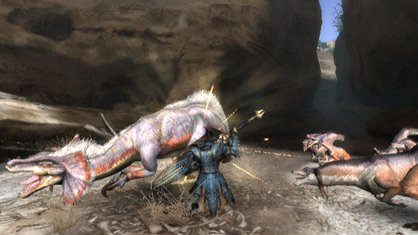Monster Hunter Tri - hands-on
We spent most of our youth hacking up make believe monsters. Tree stumps, bushes, neighbours’ pets – all it takes is a bit of imagination and no friends. It’s the key difference between gamers and non-gamers. The non-gamers embraced the magic of childhood looking for Where the Wild Things Are. We, on the other hand, asked Where the Wild Things Are Because We Want to Hit Them With Rakes. Gamers are destructive. Luckily, so are Capcom.

After landing at Moga Island’s quaint fishing docks – the main (and literal) port of call for the single-player adventure – it takes roughly three minutes to kill your first monster. Step 1: Purchase whomping stick (a Great Sword, just under twice our height). Step 2: Enter the mountains. Step 3: Whomp away. The kill undermines Moga’s natural splendour. Stepping out onto the mountain plateau and seeing the island stretch out takes the breath away – think Sam Neill eyeing Jurassic Park for the first time. Only in our version, Neill then pulls out a rocket launcher and nails the nearest brontosaurus.
We defy you not to. Monster Hunter Tri trades entirely on your desire to hit big ’orrible creatures with big ’orrible weapons. Give us a sword twice our height and of course we’ll smack the nearest living thing. Fans don’t pour hundreds of hours into this game gawping at ecosystem AI – motivation stems entirely from the lure of bigger, pointier sticks, and bigger, nastier monsters to be poked. Step back and the entire game is driven by one cruel cycle of production: kill monster, harvest bones and skin to build bigger weapon, kill bigger monster, harvest bigger bones... and so on.

Combat takes time to get used to. You can swipe. You can roll. You can, er, did we mention the swiping? Balletic grace is not the order of the day. Fighting is all about endurance – dodging hugely overpowered attacks coming your way – and finding opportunities to deliver deadly, but lumbering blows. Our first kill – a defenceless baby herbivore (hey, we’re not proud) – was left a horrible spasming pile in one blow. Capcom let you have this one to ease you in - from there on monsters are set to ‘hand ass to you’ mode. And they do.
Jagii, Tri’s velociraptors, swarm around in true ‘clever girl’ fashion. A Great Sword will put an end to their face-snacking routine, but the blighters can easily weave past the treacle-slow wind-up. Some monsters you won’t want to kill outright. Slaying the Bambi-like Kelbi can damage their horns – knock them out with a hammer and you can carve off the horn with greater success (sounds horrible when you put it in words). When you fight the big ‘boss’ monsters, your game has to improve again – learning weapon combos and using items to bait, trap and stun.

In time, crude swipes reveal hidden nuances. Take our Great Sword, for example. Wide enough to hide behind, it can block, but every hit it deflects dulls it a bit. So you have to keep sharpeners on you. Damage is decided on which part of the blade collides – dig in the thick middle section for maximum hurt. Horizontal slashes can clear beasts in an arc around you, while its immense length proves effective against aerial enemies. Online, its upward slash can even be used to catapult fellow hunters out of danger. And this is but one of seven weapon classes.
All this is done from the comfort of the Classic Controller. After five minutes’ play we abandoned the remote for the favoured scheme – Tri comes with the redesigned Classic Controller Pro in Japan. What a godsend the second analogue stick is. We’ve spent so long with the Nunchuk we’d almost forgotten what it was like to swivel a camera with a second nubbin. Rotating Moga’s wondrous peaks is a sight to behold, stopped short when the camera reveals a Jagii pouncing on us from behind.

Death comes quickly in Monster Hunter Tri. This was much easier when the monster was atrash bag full of leaves. But you persevere; the lure of wrenching out a spine is too strong. And we’ve not even stepped off Moga yet, into the ice, desert and underwater realms beyond.
Weekly digests, tales from the communities you love, and more
Feb 4, 2010


